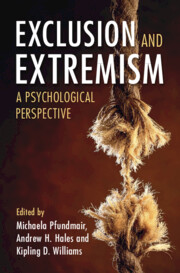Book contents
- Exclusion and Extremism
- Exclusion and Extremism
- Copyright page
- Dedication
- Contents
- Contributors
- Introduction
- Part I The Link between Exclusion and Extremism
- Part II Drivers of the Exclusion–Extremism Link
- 6 Extremism and Exclusion
- 7 Divided Groups, Polarized Identities, and Extremist Behavior
- 8 It’s the Group, Not Just the Individual
- 9 “Who Do They Think We Are?!”
- 10 The Exclusion–Extremism Link in Non-WEIRD Populations
- Part III Topics Related to the Exclusion–Extremism Link
- Index
- References
7 - Divided Groups, Polarized Identities, and Extremist Behavior
The Role of Exclusion-Contingent Self and Identity Uncertainty
from Part II - Drivers of the Exclusion–Extremism Link
Published online by Cambridge University Press: 16 May 2024
- Exclusion and Extremism
- Exclusion and Extremism
- Copyright page
- Dedication
- Contents
- Contributors
- Introduction
- Part I The Link between Exclusion and Extremism
- Part II Drivers of the Exclusion–Extremism Link
- 6 Extremism and Exclusion
- 7 Divided Groups, Polarized Identities, and Extremist Behavior
- 8 It’s the Group, Not Just the Individual
- 9 “Who Do They Think We Are?!”
- 10 The Exclusion–Extremism Link in Non-WEIRD Populations
- Part III Topics Related to the Exclusion–Extremism Link
- Index
- References
Summary
Feeling marginalized, silenced and excluded, as an individual or as a (sub)group within a collective, can make one feel uncertain about one’s self and identity and about “fitting in.” This feeling of uncertainty can be reduced by group identification – especially with a distinctive group that has a clearly defined, unambiguous, and homogenous social identity. Such groups and identities can sometimes be characterized as extremist. Excluded individuals may exit the larger group to identify with a different and possibly more extreme group, and the larger group may thus become less diverse and more homogeneous and extreme itself. Members of excluded subgroups can bond tightly together as a highly distinctive entity and identify strongly with it, a process that can fragment and polarize the larger group into oppositional or combative factions. In this chapter we draw upon an uncertainty identity theory framework to describe how exclusion can generate self and identity uncertainty, which is resolved by a process of identification that fragments groups and can produce extremist groups and identities.
- Type
- Chapter
- Information
- Exclusion and ExtremismA Psychological Perspective, pp. 141 - 165Publisher: Cambridge University PressPrint publication year: 2024

